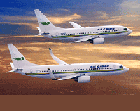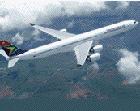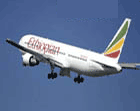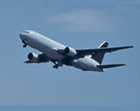 |
|
|
|
|
|
|
|
|
|
|
Quick Now! Who's Number One on Google for USA African Tourism? Answer

...
In 1995, we
launched two unique travel business publications, Africa
Travel Magazine and Air Highways Magazine (see
web
site). Until now Air
Highways print editions have focused on North America, plus
a special Asia Pacific - APEC Conference Edition. In March,
2006, both prestige magazines combine forces in "Air
Highways to Africa." Continued Airline
of the Year 2004 - Final Rankings 1st Singapore
Airlines 2nd Emirates
3rd
Cathay
Pacific 4th
Qantas
Airways 5th Thai
Airways 1st Hong
Kong Int'l Airport 2nd Singapore
Changi Airport 3rd
Amsterdam
Schiphol Airport 4th
Seoul
Incheon Airport 5th Kuala
Lumpur KLIA Airport Asia Asian
Airlines South
America TAM
Brazilian Regional-
Europe PGA
Portugalia Regional-
Europe SN
Brussels Airlines Pacific Air
Tahiti Nui Asia Bangkok
Airways Mid
East / Africa Qatar
Airways North
America JetBlue
Airways Improvement Gulf
Air
In the 1960s it was a common thing to pack
your bags, get to the airport and eventually to the aircraft without
being stopped by any one other than the customs, immigration and
airline personnel. Those luxuries have however faded with time
thanks to the ever evolving threats against civil aviation.
Passenger to baggage reconciliation, effective
landside/airside barriers, effective access control, screening of
passengers cabin and hold luggage, cargo and mail security are just
but some of the measures put in place to provide security to civil
aviation. These measures have had their successes in
bringing down the number of security incidents in recent years.
It is sad to note that many African states
still believe that threats are not directed to Africans and
therefore they should not use their meager resources to protect
"others". This only serves to worsen the state of affairs. Kenya,
for instance has learnt that it is now a direct target by AL-Shaabab
terrorist group (Somalia based). This in extension means that
African countries under the African Union banner similarly stand
under threat from such terrorist groups. It is an open secret that
African airports are ill-funded and where this is not the case there
lacks political goodwill to address aviation security. Aviation
security has not been considered a priority spending area. Indeed it
is the cost of these strategies that bog many African countries. It
is even worse off if the cost of keeping the strategies afloat do
not match the benefits from aviation itself. After all who would
want to invest in a venture that does not break-even? The lack of
adequate knowledge and capacity to understand and deal with the
threats is the major impediment to fully administer adequate and
appropriate countermeasures for the threats. Airports have also been faced by the challenge
of infrastructural development and maintenance which more often than
not take up huge chunks of their budgets. Airports however have to
look at the need for strategies based on risk management that
basically looks at what would happen if things went wrong. This will
enable them to relook at their priorities. Kenya Airports Authority is a state-owned
corporation with the mandate of developing, managing and maintaining
civil aviation airports in Kenya. Being a country that relies
heavily on tourism, floriculture and its strategic geographical
location as an aviation hub, Kenya treasures the immense
contribution of aviation to its gross domestic product. It is
therefore ideal to look at the strategies and efforts of the Kenyan
airports in protecting the aviation industry from the new and
emerging threats. Notable of Kenya Airports Authority was the
shift to new management structures that lay emphasis on performance
management as opposed to the old bureaucratic systems that hitherto
existed. This has evidently borne some fruits as seen from the
steady growth of the organization's key statistics on revenues,
passengers and cargo. The authority through coordination of
government agencies and stakeholders has been able to provide
layered security measures that minimize the chances of perpetrators
succeeding in their intentions. For instance, the Immigrations
Department is well within the International Civil Aviation 2015
deadline of issuing machine readable passports. Such a move will
greatly reduce cases of fraudulent travel documents being used by
would-be-perpetrators of terrorist activities. Additionally, there
exists a strict vetting procedure for airport workers applying for
airport movement permits. This serves as one of the remedies for
dealing with insider threats. Technology has proved to be an all round
effective measure to tackle the dynamics of the emerging threats. To
achieve this, Kenya Airports Authority has invested heavily in
state-of-the-art security equipment such as X-ray machines,
explosive trace detectors, full body scanners and surveillance
systems. This has and will continue to be enhanced following
deliberate benchmarking by the organization on the industry's
international best practices in countries like South Korea,
Singapore and Israel. The benefits of training in aviation cannot be
overlooked. The airport community at large has been and will
continue to be entrenched in the security system through the
security awareness programs. Remember airports are more than just
terminals and runways. They are busy commercial neighborhoods; and
that means we must be vigilant everywhere there is a possible
threat. But more specifically the organization has devoted a
substantive budget to training of its key security personnel in both
theoretical and practical course work. The security staffs are well
trained to understand exactly what they are up against…. "If you do
not know what you are looking for you will definitely not find it".
Kenya Airports Authority is in the process of implementing a Secure
Freight Program which is now at an advanced stage. On completion
Kenya will be the first country in the region to boast of this
system. A great plus indeed. The airport authority has played a pivotal
role in the regional integration process in East Africa. The efforts
of Civil Aviation Authorities and airport authorities from the
member States, i.e Kenya, Uganda, Tanzania, Rwanda and Burundi,
brought about the birth of Civil Aviation Safety and Security
Oversight Agency (CASSOA). CASSOA has the responsibility of
harmonizing regulations, standards and procedures for the member
states as far as aviation safety and security is concerned. This in
the long run will enhance positive sharing of resources in the
region. The strategies outlined above are just but a
few that African States can adopt in ensuring that they keep pace
with the ever evolving threats in the aviation industry. African countries need to understand that
their nations are their most valued treasure; and should therefore
not treat things that concern their motherland lightly. Open Sky and Tourism
Development The African Airlines
Association (AFRAA) is highly honored to be invited and
associated to this wonderful event of ATA in Accra. I am
particularly delighted to address this conference in Ghana,
a country of reference for its African soul, history,
culture and political inspiration. It is indeed a great
honor but at same time an uphill challenge to take the floor
before this august Assembly of Ministers of Tourism, experts
and professionals to address a core topic of their
competence; the way forward for Air Transport and Tourism
development in Africa. Many questions naturally
roam around: Can open sky policy contribute to an effective
upturn in African tourism? Are high air fares major
impediments to the blossoming of African Tourism? Why after
50 years of independence and self governance, most of
African countries are still loitering and questing for the
right market and attractive tourism development strategy?
These questions need to be squarely answered without
complacency if Africa really wants to pave the way to
tourism development. 1. African poor performance
and easy scapegoats 2. Products and best
practices in the profession 3. Afraa
recommendations African poor performance and easy
scapegoats Tourism is one of the
biggest and fasted developing industries in the world:
generating total revenue of about $500 billion in 2004. Out
of this huge turnover, Africa accounts for a mere $7.5
billion which represent 2.5% of the world tourism revenue.
In term of traffic, the number of tourists recorded in 2004
was 750 millions in the world out of which barely 25
millions (4.5%) visited Africa. These African Tourists
travel to very few countries across the continent, which
ranks as follows: South Africa 6,1
millions Egypt 5.5
millions Morocco 5
millions Tunisia 5
millions Zimbabawe 1
million Other countries that
received significant but less than one million tourists in
2004, include: . Kenya and
Tanzania . Botswana .
Mauritius . Nigeria . Senegal
and . Ghana In most of the countries in
Africa, the yearly tourism traffic computed so far is
between one and twenty thousands. The question is why are
these countries not moving forward so as to take their faire
share in this growing service industry, which does not
require any high technology and so remains one of the most
accessible economic development sectors to developing
countries? We do not probably fully
realize in Africa the macroeconomic development potentials
of the tourism industry. It is our dear wish to receive
tourists but, have we ever designed and put in place any
policy and strategy to effectively achieve this
objective? For instance, countries that
put their hope for salvation in oil production invite
experts from all corners of the world to undertake research
and exploration across their territories. Do we witness such
mobilization of specialists to organize our tourism and dig
out its wealth? I am confident that this ATA
event is meant to strongly contribute to such a
move. Allow me at this juncture,
to take the opportunity to put into perspective some
misleading analysis on the lack of development of African
Tourism. Many in their quarters blame
the poor development of African tourism on high air fares
and also believe that an open sky policy would be a panacea
for the continent. I wish to touch briefly on these subjects
with you. Air Fares The Tourism market is one of
the most globalized in the world. In the decision making
process of a tourist travelers, the whole world has become a
small village - distance or cost ceases to be determining
factor. The choice of a destination by a tourism is driver
by its attractiveness in terms of the facilities,
convenience, accessibility and uniqueness. Cost
consideration and air fare rank secondary in the choice of a
destination for most tourists. It is for this reason, that
South Africa, Zimbabwe, Mauritius and Kenya receive more
European tourists that Mauritania, Mali, Niger and even
Ghana and Togo though the air fares to the latter countries
are normally lower because of the comparative proximity to
Europe. It is against the same
background that Americans and Europeans tourists fly more
often to Asia than to Africa despite the longer distance and
higher air fare. Open Sky policy is not a
major driver of tourism development in the existing African
environment. In fact, open sky policy is expected to pave
the way for more air services, more competition and to
cheapen air fares which would stimulate the tourist
traffic. The reality is that without
attractive packaged tourist products on site, no tourist
traffic can be generated and therefore no airline would be
willing to lay-on services despite the open sky policy. For
example, countries such a as Tanzania, Mali, and Cape Verde
have signed an open sky agreements with the USA without any
positive impact on their tourism industry. The signing of
open agreements must be backed by a concerted effort by the
State and the industry players to work together in offering
comprehensive products that are unique, attractive and
competitive. Ironically, since Ghana
signed the Open sky agreement with the USA, the number of
direct flights operating between Ghana and the USA has
dramatically reduced. Though the number of American tourists
visiting Ghana might have increased over the years, the
growth may be attributed to the creativity and ingenuity of
the Ministry of Tourism through events such as Panafest and
other cultural and ecotourism festivals that the country
markets globally. Air fares and open sky
policy are parameters that can help enhance tourism in an
attractive environment. They are not major tourism
development drivers. Once a destination offers most of the
attractions tourists are looking for, people will want to
visit them irrespective of the costs and the associated
difficulties of getting there. The sole and unique driver of
tourism therefore is the product package that a destination
offers. It should meet the expectations of the
market. Products and best
practices in the profession Two types of personalities
are involved in mass tourism travels. A full time worker who
has saved money the whole year to travel for his holiday and
a retired person who has saved his whole life, has now time
and would like to tour the world. The demand of these two
clients is the same; 1. They want fun, a break, a
change in their life for a week or two. As tourist guests,
they want to be pampered, taken care of and kept busy all
days through a diversity of visits, discoveries and
fun. 2. Though they are highly
interested in wild life and other natural sites, they would
like to continue enjoying the same level of comfort they
have at home and even more. This includes hotel
accommodation, food and restaurant, ground transport,
telecommunication facilities (phone, internet, etc.) and
last but not the least, security. This list of requirements
clearly shows that natural landscapes, mountains, sea shores
or wild life by themselves would not yield tourism
development, no matter how beautiful they are, unless an
appropriate environment is created around them, to provide
dreaming holiday time, fun, break and change. Most African countries have
left their natural tourist attractions in their original
state without any such additional touches to make them
actual tourist resorts, where people can enjoy and rejoice.
Here are the main reasons for the poor tourism performance
of most African countries. In addition, high visa fees,
airport taxes and difficulties in securing visas all reduce
the attractiveness of some African destinations to tourists
and particularly to African tourists. Physical infrastructure
development in many parts of Africa is inadequate. Roads,
rails infrastructure, particularly to tourist sites outside
the main cities are mostly in deplorable states. This makes
visits to tourists sites located outside the cities not only
expensive but also sometimes risky. There is also inadequate
provision of security, public health care and institutional
capacity building in this profession in many parts of
Africa. This deters some visitors. Good hotel accommodation is
also difficult to find in many areas. With tourism in Africa
expected to grow to 47 million by 2010, are we putting plans
in place to provide the corresponding levels of quality
hotels accommodation? If infrastructure fails to
match demand, either now or in the future, we cannot achieve
any meaningful growth of this industry Packaging of the tourist
product The various players in the
industry; transporters, hoteliers, tour operators,
restaurants, amusement centers, etc. operate independently
of each other. For instance in many African countries,
tourists have to make their own hotel reservations, plan
their own ground transportation and movement, decide where
to eat, etc. This creates a lot of avoidable stress and
inconvenience. The lack of properly
packaged tourist products robs the tourism industry of the
benefits of synergy and economies of scale, which otherwise
could have been passed on to them in the form of lower tour
packages. We are convinced that
working together, the stakeholders in this industry can make
African tourism very competitive. After all, Africa is
richly endowed with beautiful coastlines, wildlife, nature
and diverse cultures, which are to some extend unique to the
continent. AFRAA
recommendations 1. Creation of tourism
development authorities In the African Millennium
Development Goals (MDGs) tourism is viewed as one of the
most important sectors that can contribute to the overall
development of the continent. As such, the tourism sector
should be organized and run as a business project,
autonomous from Government's general administration with its
own budget, objective and economic result
targets. Such an autonomous body
would access all the needs and requirements for appropriate
tourism development and take initiatives to be responsive to
these needs. These initiatives should include: . Road reconstruction
(pavement) . Hotel and lodge
construction . Wild life reserves and
parks organization . Cleaning of the sea shores
and other tourist sites . Road transport
arrangements . Financial support and
incentive to private sector to get fully involved 2. Security
Enhancement African countries must
heighten the security and protection provided for their
tourist guests The police presence and security assurance
should be visible all over so as to make tourists feel
confident and comfortable. Harassment by beggars along
streets and cross roads should be seriously dealt with to
avoid all sorts of embarrassment. Road transport charges
should be fixed, published and controlled so as to avoid
cheating of foreigners 3. Promotion on Overseas
Markets Tourism development
authorities will have to use experts of the main tourist
markets such as those of ATA to help them understand the
motivations of the tourists, assess their expectations and
design with the intelligence of these insiders, the
appropriate products to offer. Once the products are
defined, they would need to be promoted on over sea markets
with the assistance of the same associate
experts. Events such a as African
days should be organized on site in the US and European
countries with African cultural performances. We need to penetrate the
restaurant sector in the US, Europe, and Asia with African
cuisine and entertainment so as to slowly incite the general
public to visit Africa without apprehension. These types of
action should be directly initiated, engineered and
monitored by the tourism development authorities 4. Development of a New
Air Transport Policy and Creation of Strong
Carriers Across the world, there is
no tourism thriving country without at least a strong
national carrier to back the economic performance of the
sector. In Africa for instance, the top tourist countries
have the most important airlines. They are South Africa,
Egypt, Morocco, Tunisia, Kenya and Mauritius. The Tourists traffic
increases the activities of the airline and most of the
time, the domestic airline airline operations enlarge the
scope of products that the country can offer nationwide and
the tourists feel save to deal with the same carrier that
has an office in their countries back home. Reliable air services and
national airline development must definitively be part of
the agenda of the tourism development
authorities. Once the traffic is there,
it would not matter how many carriers are operating,
competition would prevail and air services will improve and
costs reduce for the benefits of the travelers and also for
a much more developed tourism and airline
industries. State of Air Transport
Industry in Africa I wish to say a word on the
state of the airline industry in Africa in this area of
globalization. As it is showing on the map
before you, most of African countries' skies are dominated
by European carriers. In the West and Central Africa, they
provide the only links with the rest of the
world. Even on Intra-African
routes, our airlines don't operate reliable air services
across the sub-regions. They are actually too small to be
effectively responsive to the market's needs. As they are
now, they cannot really drive any intra- African tourism
development. Currently, all the African
major players, such as Ethiopian Airlines, Kenya Airways,
Royal Air Maroc, South African Airways and Afriqiyah are
enlarging their networks to all destinations in this region.
Emirates are expanding tremendously on the same routes.
Delta Airlines has announced operations from the
USA. There no doubt, this region
has turned to be an air traffic gold mine but the local
economic operators don't know ow how to transform it into
wealth. This will never happen
unless: - We address the airlines
small size issue - We stop believing in the
ideology of "Do it alone and by yourself" -Governments take out their
hands from the business management and facilitate
privatization -Private interests across
borders team up to create in the region multinational
private carriers. In any case, the
Yamoussoukro Decision which is the Continent liberalization
program for African carriers must fully and totally
implemented so as to enhance the number of air services
across the continent, what is dearly need to speed up Africa
economic integration, political Union and Tourism
development. Conclusion I have deliberately escaped
from the narrow areas of high fares and open sky where
usually tourism and airline experts undertake endless
debates. I am actually more
interested in development strategies in your section
because, tourism ranks among the few gold mines that Africa
can easily explore and derive wealth from Tourism prosperity would be
that of the airlines and I believe that the airline industry
is indispensable for the continent economic integration and
development. As you can see, Tourism and
Airline Industries are key factors for the continent's
economic salvation. We need to realize it and work together
hand in hand toward this

Airport
of the Year 2004 - Final Rankings
2004
Airline Excellence Awards
by Christian
Folly-Kossi Secretary General of Afraa







